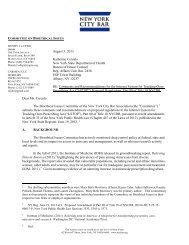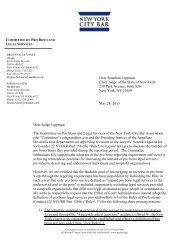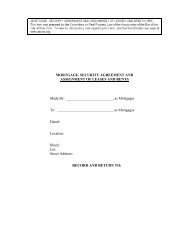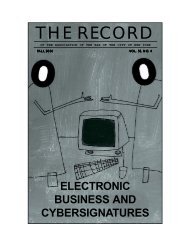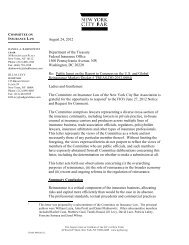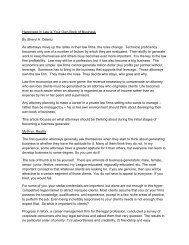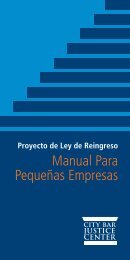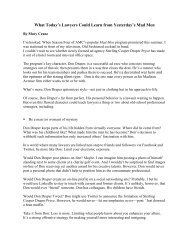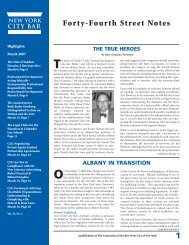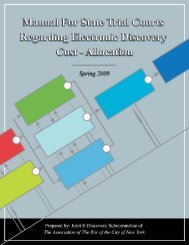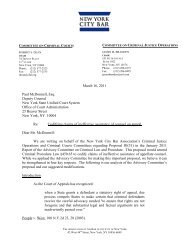2007 Issue 1 - New York City Bar Association
2007 Issue 1 - New York City Bar Association
2007 Issue 1 - New York City Bar Association
Create successful ePaper yourself
Turn your PDF publications into a flip-book with our unique Google optimized e-Paper software.
C I V I L R I G H T S, I N F O R M A T I O N T E C H N O L O G Y L A W,<br />
L E G A L I S S U E S A F F E C T I N G P E O P L E W I T H D I S A B I L I T I E S<br />
provided in a person’s home, over the telephone, through the<br />
mail, or via the internet—is inconsistent with Congress’s clearly<br />
expressed intent.<br />
4. Website Accessibility Directly Serves Congressional<br />
Intent as Expressed in the ADA’s “Findings and Purposes”<br />
and its Legislative History<br />
Neither the ADA nor its legislative history discusses the Internet or<br />
the Web, and Congress did not anticipate the application of the ADA to<br />
the Internet. This is no barrier, however. The ADA is a “broad remedial<br />
statute that should be construed broadly to effectuate its purposes.” 35 As<br />
the Supreme Court has held, “that [Title III of the ADA] can be applied in<br />
situations not expressly anticipated by Congress does not demonstrate<br />
ambiguity. It demonstrates breadth.” 36 In other contexts, the Supreme Court<br />
has continually held that Congressional statutes do not freeze time so as<br />
to apply only to situations available at the moment of the law’s passage.<br />
To the contrary, “[w]hen technological change has rendered its literal terms<br />
ambiguous, [an] Act must be construed in light of [its] basic purpose.” 37<br />
All of Congress’ “Findings and Purposes” 38 regarding the aim of the<br />
ADA point toward Website accessibility. The ADA is “a clear and comprehensive<br />
national mandate for the elimination of discrimination against<br />
individuals with disabilities.” 39 The statute’s purpose is to “invoke the sweep<br />
of Congressional authority . . . to regulate commerce, in order to address<br />
the major areas of discrimination faced day-to-day by people with disabilities.”<br />
40 Congress found that “society has tended to isolate and segregate<br />
individuals with disabilities,” in “public accommodations” and “communications.”<br />
41 Discrimination arises through “communication barriers”<br />
35. Arnold, 136 F.3d at 861.<br />
36. PGA Tour, Inc. v. Martin, 532 U.S. 661, 689 (2001) (professional golfer with disability must be<br />
allowed to use golf cart, rather than walking, on the PGA tour) (internal citation omitted).<br />
37. Twentieth Century Music Corp. v. Aiken, 422 U.S. 151, 156 (1975) (broadcasting a<br />
copyrighted work via a restaurant radio does not constitute a separate “performance” of the<br />
work requiring additional royalty payment to the copyright holder) (citing Fortnightly Corp. v.<br />
United Artists, 392 U.S. 390, 395 (1968 ) (“Our inquiry cannot be limited to ordinary<br />
meaning and legislative history, for this is a statute that was drafted long before the development<br />
of the electronic phenomena with which we deal here.”)).<br />
38. 42 U.S.C. § 12101.<br />
39. Id. § 12101 (b)(1).<br />
40. Id. § 12101 (b)(4).<br />
41. Id. § 12101 (a)(2), (3).<br />
T H E R E C O R D<br />
128



